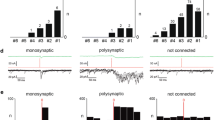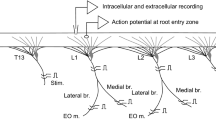Abstract
This study compares some characteristics of the disynaptic excitatory pathways from the lateral vestibular nucleus (LVN) and medial longitudinal fasciculus (MLF) to lumbosacral α-motoneurons in the decerebrate cat. We used the spatial facilitation technique to test whether disynaptic LVN and MLF excitatory postsynaptic potentials (EPSPs) are produced by common last-order interneurons in the lumbosacral segments of the spinal cord. Of 77 motoneurons examined, 26 exhibited disynaptic EPSPs from both supraspinal sources. No spatial facilitation was found between LVN and MLF EPSPs in 21 of 24 cells that were adequately tested. In 3 of 23 cells (all flexor motoneurons), some spatial facilitation was found in some but not all trials. These observations suggest that stimulation of the LVN and MLF produces disynaptic EPSPs in motoneurons through largely separate populations of last-order interneurons. Disynaptic MLF and LVN EPSPs showed parallel patterns of modulation during fictive locomotion. Maximal disynaptic EPSP amplitudes occurred during the phase of the step cycle when the recorded motoneuron, whether flexor or extensor, exhibited depolarizing locomotor drive potentials and the corresponding muscle nerve was active. These observations, taken together, suggest that disynaptic LVN and MLF EPSPs are produced in motoneurons by at least four separate populations of segmental last-order excitatory interneurons, with separate populations projecting to flexor versus extensor cells. The results also suggest that the modulation of the disynaptic EPSPs during fictive locomotion is mainly due to premotoneuronal convergence of input from the respective descending systems and from the segmental central pattern generator for locomotion onto common interneurons.
Similar content being viewed by others
References
Bussieres N, Dubuc R (1992) Phasic modulation of vestibulospinal neuron activity during fictive locomotion in lampreys. Brain Res 575:174–179
Davies HE, Edgley SA (1994) Inputs to group II-activated midlumbar interneurons from descending motor pathways in the cat. J Physiol (Lond) 479:463–473
Drew T, Dubuc R, Rossignol S (1986) Discharge patterns of reticulospinal and other reticular neurons in chronic, unrestrained cats walking on a treadmill. J Neurophysiol 55:375–401
Eccles JC, Eccles RM, Lundberg A (1957) The convergence of monosynaptic excitatory afferents on to many different species of alpha-motoneurones. J Physiol (Lond) 137:22–50
Feldman AG, Orlovsky GN (1975) Activity of interneurons mediating reciprocal la inhibition during locomotion. Brain Res 84:181–194
Fleshman JW, Rudomin P, Burke RE (1988) Supraspinal control of a short-latency cutaneous pathway to hindlimb motoneurons. Exp Brain Res 69:449–459
Floeter MK, Sholomenko GN, Gossard JP, Burke RE (1993) Disynaptic excitation from the medial longitudinal fasciculus to lumbosacral motoneurons: modulation by repetitive activation, descending pathways, and locomotion. Exp Brain Res 92:407–419
Forssberg H (1979) Stumbling corrective reaction: a phase-dependent compensatory reaction during locomotion. J Neurophysiol 42:936–953
Frazier DT, Narahashi T, Yamada M (1970) The site of action and active form of local anesthetics. II. Experiments with quaternary compounds. J Pharmacol Exp Ther 171:45–51
Gossard J-P, Floeter MK, Burke RE (1993) Excitation of lumbar motoneurons from the medial longitudinal fasciculus (MLF) and lateral vestibulospinal tract (LVST) does not converge on common last-order interneurons. Soc Neurosci Abstr 19:541
Grillner S (1981) Control of locomotion in bipeds, tetrapods and fish. In: Brooks VB (eds) Handbook of physiology, sect 1, The nervous system, vol II, Motor control, part 2. American Physiological Society, Washington, DC, pp 1179–1236
Grillner S, Hongo T (1972) Vestibulospinal effects on motoneurones and interneurones in the lumbosacral cord. In: Brodal A, Pompeiano O (eds) Basic aspects of central vestibular mechanisms. Elsevier, Amsterdam, pp 243–262
Grillner S, Lund S (1968) The origin of a descending pathway with monosynaptic action on flexor motoneurones. Acta Physiol Scand 74:274–284
Grillner S, Hongo T, Lund S (1970) The vestibulospinal tract: effects on alpha-motoneurones in the lumbosacral spinal cord in the cat. Exp Brain Res 10:94–120
Grillner S, Hongo T, Lund S (1971) Convergent effects on alphamotoneurones from the vestibulospinal tract and a pathway descending in the medial longitudinal fasciculus. Exp Brain Res 12:457–479
Hultborn H, Udo M (1972) Convergence in the reciprocal Ia inhibitory pathway of excitation from descending pathways and inhibition from motor axon collaterals. Acta Physiol Scand 84:95–108
Jell RM, Elliott C, Jordan LM (1984) Initiation of locomotion from the mesencephalic locomotor region: effects of selective brainstem lesions. Brain Res 328:121–128
Lundberg A (1979) Multisensory control of spinal reflex pathways. In: Pompeiano O (ed) Reflex control of posture and movements. Elsevier, Amsterdam, pp 11–28
Moschovakis AK, Sholomenko GN, Burke RE (1991) Differential control of short latency cutaneous excitation in cat Fdl motoneurons during fictive locomotion. Exp Brain Res 83:489–501
O'Donovan MJ, Pinter MJ, Dum RP, Burke RE (1982) The actions of FDL and FHL muscles in intact cats: functional dissociation between anatomical synergists. J Neurophysiol 47:1126–1143
Omeniuk DJ (1989) Synaptic effects from cutaneous afferents in alpha motoneurons PdD thesis, George Washington University School of Medicine, Washington, DC
Orlovsky GN (1970) Work of the reticulo-spinal neurones during locomotion. Biophysics 15:761–771
Orlovsky GN (1972a) Activity of vestibulospinal neurons during locomotion. Brain Res 46:85–98
Orlovsky GN (1972b) The effect of different descending systems on flexor and extensor activity during locomotion. Brain Res 40:359–371
Perreault MC, Drew T, Rossignol S (1993) Activity of medullary reticulospinal neurons during fictive locomotion. J Neurophysiol 69:2232–2247
Perret C (1983) Centrally generated pattern of motoneuron activity during locomotion in the cat. Soc Exp Biol Symp 37:405–422
Quevedo J, Eguibar JR, Jimenez I, Rudomin P (1992) Differential action of (-)-baclofen on the primary afferent depolarization produced by segmental and descending inputs. Exp Brain Res 91:29–45
Pratt CA, Jordan EM (1987) Fa inhibitory interneurons and Renshaw cells as contributors to the spinal mechanisms of fictive locomotion J Neurophysiol 57:56–71
Rall W, Burke RE, Nelson PG, Smith TG, Frank K (1967) The dendritic location of synapses and possible mechanisms for the monosynaptic EPSP in motoneurons. J Neurophysiol 30:1169–1193
Rudomin P, Engberg I, Jimenez I (1981) Mechanisms involved in presynaptic depolarization of group I and rubrospinal fibers in cat spinal cord. J Neurophysiol 46:532–548
Rudomin P, Jimenez I, Enriquez M (1991) Effects of stimulation of group-I afferents from flexor muscles on heterosynaptic failitation of monosynaptic reflexes produced by Ia and descending inputs: a test for presynaptic inhibition. Exp Brain Res 85:93–102
Russel DF, Zajac FE (1979) Effects of stimulating Dieters' nucleus and medial longitudinal fasciculus on the timing of the fictive rhythm induced in cats by DOPA. Brain Res 177:588–592
Schmidt BJ, Meyers DER, Fleshman JW, Tokuriki M, Burke RE (1988) Phasic modulation of short-latency cuntaneous excitation in flexor digitorum longus motoneurons during fictive locomotion. Exp Brain Res 71:568–578
Schmidt BJ, Meyers DER, Tokuriki M, Burke RE (1989) Modulation of short latency cutaneous excitation in flexor and extensor motoneurons during fictive locomotion in the cat. Exp Brain Res 77:57–68
Shapovalov AI (1969) Posttetanic potentiation of monosynaptic and disynaptic actions from supraspinal structures on lumbar motoneurons. J Neurophysiol 32:948–959
Shefchyk SJ, Jordan LM (1985a) Motoneuron input-resistance changes during fictive locomotion produced by stimulation of the mesencephalic locomotor region. J Neurophysiol 54:1101–1108
Shefchyk SJ, Jordan LM (1985b) Excitatory and inhibitory postsynaptic potentials in alpha-motoneurons produced during fictive locomotion by stimulation of the mesencephalic locomotor region. J Neurophysiol 53:1345–1355
Shefchyk SJ, McCrea D, Kriellars D, Fortier P, Jordan EM (1990) Activity of interneurons within the E4 spinal segment of the cat during brainstem-evoked fictive locomotion. Exp Brain Res 80:290–295
Shik ME, Orlovsky GN (1976) Neurophysiology of locomotor automatism. Physiol Rev 56:465–501
Skinner RD, Remmel RS (1978) Monosynaptic inputs to lumbar interneurons from the lateral vestibulospinal tract and the medial longitudinal fasciculus. Neurosci Eett 10:259–264
ten Bruggencate G, Burke RE, Lundberg A, Udo M (1969) Interaction between the vestibulospinal tract, contralateral flexor reflex afferents and Ia afferents. Brain Res 14:529–532
Udo M, Oda Y, Tanaka R, Horikawa J (1976) Cerebellar control of locomotion investigated in cats: discharges from Deiters' neurons, EMG and limb movements during local cooling of the cerebellar cortex. In: Homma S (ed) Understanding the stretch reflex. Elsevier, Amsterdam, pp 445–459
Udo M, Kamei H, Matsukawa K, Tanaka R (1982) Interlimb coordination in cat locomotion investigated with perturbation. II. Correlates in neuronal activity of Deiters' cells of decerebrate walking cats. Exp Brain Res 46:559–564
Wilson VJ, Yoshida M (1969) Comparison of effects of stimulation of Deiters' nucleus and medial longitudinal fasciculus on neck, forelimb, and hindlimb motoneurons. J Neurophysiol 32:743–757
Yu J, Eidelberg E (1981) Effects of vestibulospinal lesions upon locomotor function in cats. Brain Res 220:179–183
Author information
Authors and Affiliations
Rights and permissions
About this article
Cite this article
Gossard, J.P., Floeter, M.K., Degtyarenko, A.M. et al. Disynaptic vestibulospinal and reticulospinal excitation in cat lumbosacral motoneurons: modulation during fictive locomotion. Exp Brain Res 109, 277–288 (1996). https://doi.org/10.1007/BF00231787
Received:
Accepted:
Issue Date:
DOI: https://doi.org/10.1007/BF00231787




